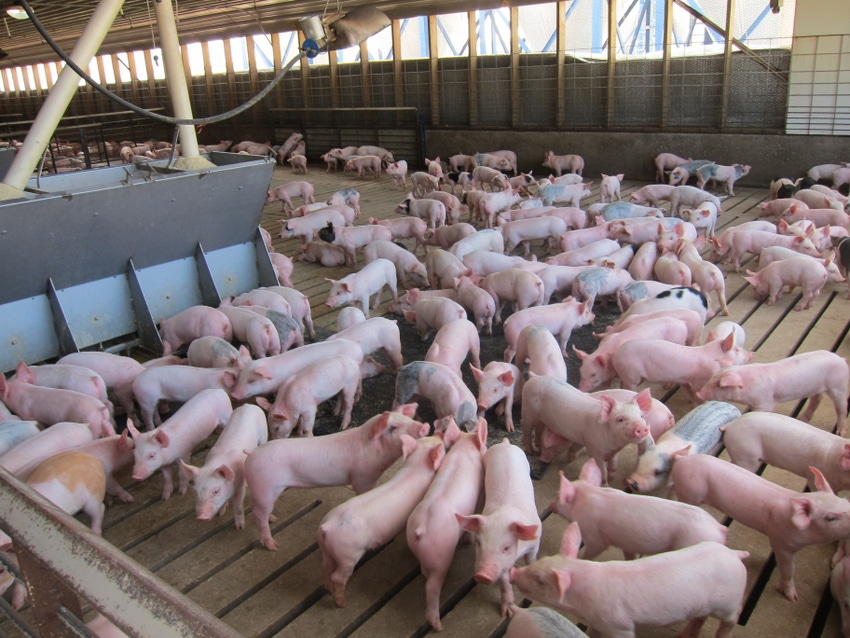The breeding herd inventory has increased by 1% to 2% over past several quarters.
September 29, 2017

By Cheryl Day
It is a story stuck on repeat — more hogs, more hogs and more hogs. In the latest quarterly Hogs and Pigs report released Sept. 28 by the USDA’s National Agricultural Statistics Service, all hogs and pigs inventory, market hogs, pig crop and pigs per litter reached fresh new highs for the quarter.
On Sept. 1, the U.S. hog herd stands at 73.5 million head, a 2% increase from a year ago and a 3% jump from the previous quarter. Breeding inventory, at 6.09 million head, was up 1% from last year whereas market hog inventory, at 67.5 million head, was up 3% from last year.
Although it appears the U.S. hog industry is expanding aggressively to fill the increased packing capacity, it is actually at a more controlled level. “The industry is growing, but at a measured pace. By doing that it is avoiding the pitfalls of the past,” explains Altin Kalo, Steiner Consulting Group senior analyst.
Looking at the reported numbers, the breeding herd inventory over the past several quarters has only increased by 1-2%. Yet, the farrowings pencil higher than expected from the June quarterly report. The record pigs saved per litter coupled with increased farrowings, solidifying U.S. excellent productivity, boosting more pounds of pork.
Still, the United States is ready to handle more hogs as two new processing plants started operations on Sept. 5. In the past few weeks, the weekly slaughter at 460,000 head has crushed last year’s record, and large weekly slaughter numbers are anticipated to continue throughout the fall.
Kevin Grier, president of Kevin Grier Market Analysis and Consulting from Guelph, Ontario, Canada, says the outbreak of porcine epidemic diarrhea virus in Manitoba will decrease the number of market pigs. As result of the outbreak, roughly 10,000 fewer feeder pigs are not entering the United States weekly to be finished in Iowa or Minnesota. While the number seems insignificant in the grand scheme, some processors are experiencing a shortage in contracted hogs.
What about demand?
Despite more pigs in the production chain, prices are steady keeping America’s pig farmers profitable during this expansion phase. “Looking from the outside, you can see it as a confident, robust industry,” says Grier.
“The volume of production and slaughter capacity is extraordinary, but at the same time the price levels, relative to supply, are good,” explains Grier. “The only possible explanation is demand. It is not just export demand but North American domestic demand for pork is very good and encouraging.”
Record production and record processing means packers have a big job in selling pork, especially in the global marketplace. As the European Union seals the deal on the recent free trade agreement with Japan, the EU will threaten U.S. market share in the Asian market.
Overall, the report tells us that the U.S. pork industry continues to grow, notes Ron Plain, professor emeritus, University of Missouri-Columbia. “Bottom line, the industry is alive and well. The slaughter capacity gives us room to grow production. I think we are going to make sure there are enough hogs to keep those employees in the new plants busy,” concludes Plain.
Quarterly Hogs and Pig report recap:
U.S. inventory of all hogs and pigs on Sept. 1 was 73.5 million head, up 2% from last year.
Breeding inventory, at 6.09 million head, was up 1% from last year, and up slightly from the previous quarter.
The June-August 2017 pig crop, at 33.0 million head, was up 2% from 2016.
Sows farrowing during this period totaled 3.10 million head, up 2% from 2016.
The sows farrowed during this quarter represented 51% of the breeding herd.
The average pigs saved per litter was a record high of 10.65 for the June-August period, compared to 10.58 last year.
Pigs saved per litter by size of operation ranged from 7.80 for operations with 1-99 hogs and pigs to 10.70 for operations with more than 5,000 hogs and pigs.
U.S. hog producers intend to have 3.07 million sows farrow during the September-November 2017 quarter, up 1% from the actual farrowings during the same period in 2016. Intended farrowings for December-February 2018, at 3.02 million sows, are up 1% from 2017.
Market hog inventory, at 67.5 million head, was up 3% from last year, and up 3% from last quarter.
Pigs under 50 pounds at 21.07 million head, up 3% from previous year
Pigs weighing 50-119 pounds at 19.63 million head, up 2% from 2016
Pigs weighing 120-170 pounds at 14.13 million head, up 4% from a year ago
Pigs over 180 pounds at 12.14 million head, up 4% from 2016
You May Also Like



